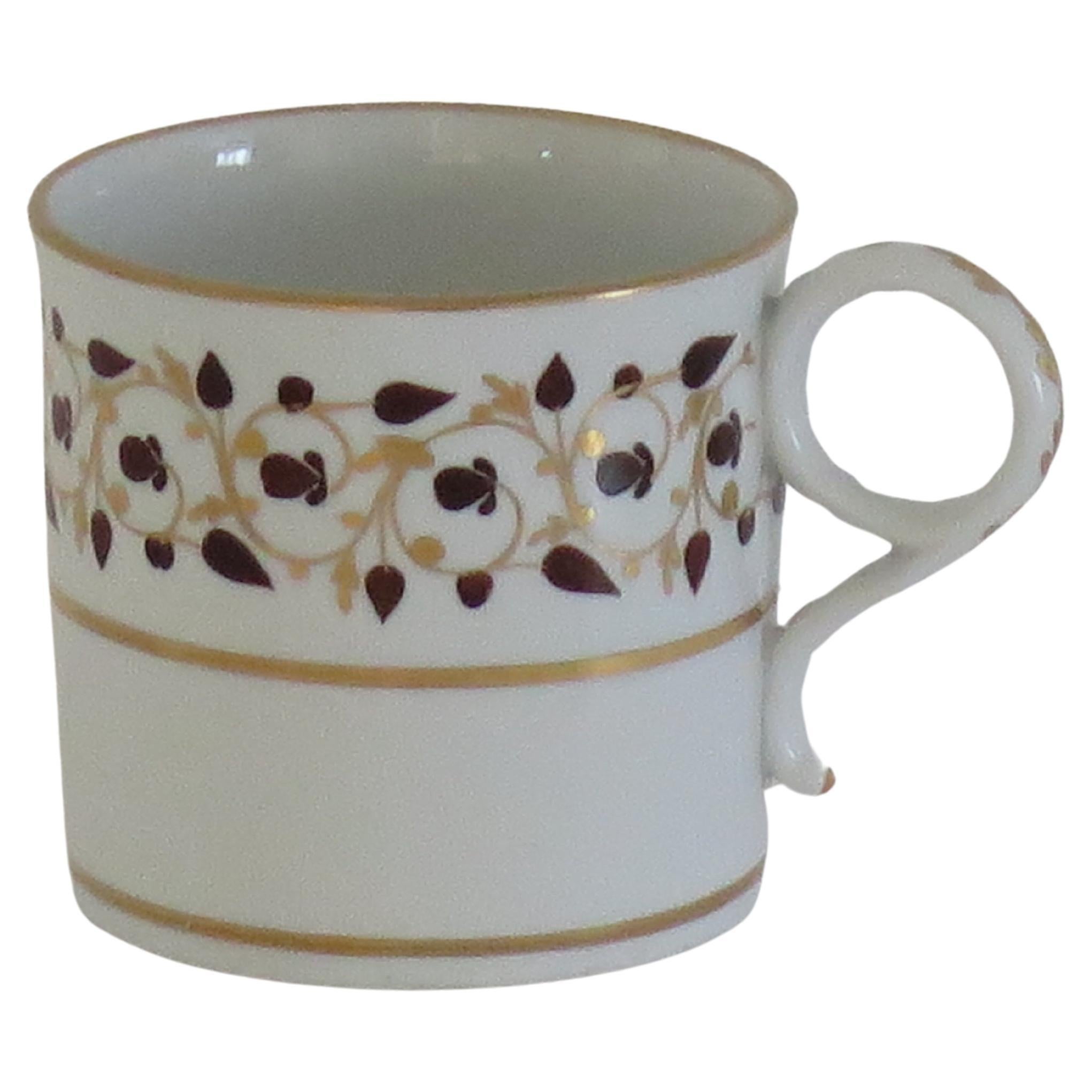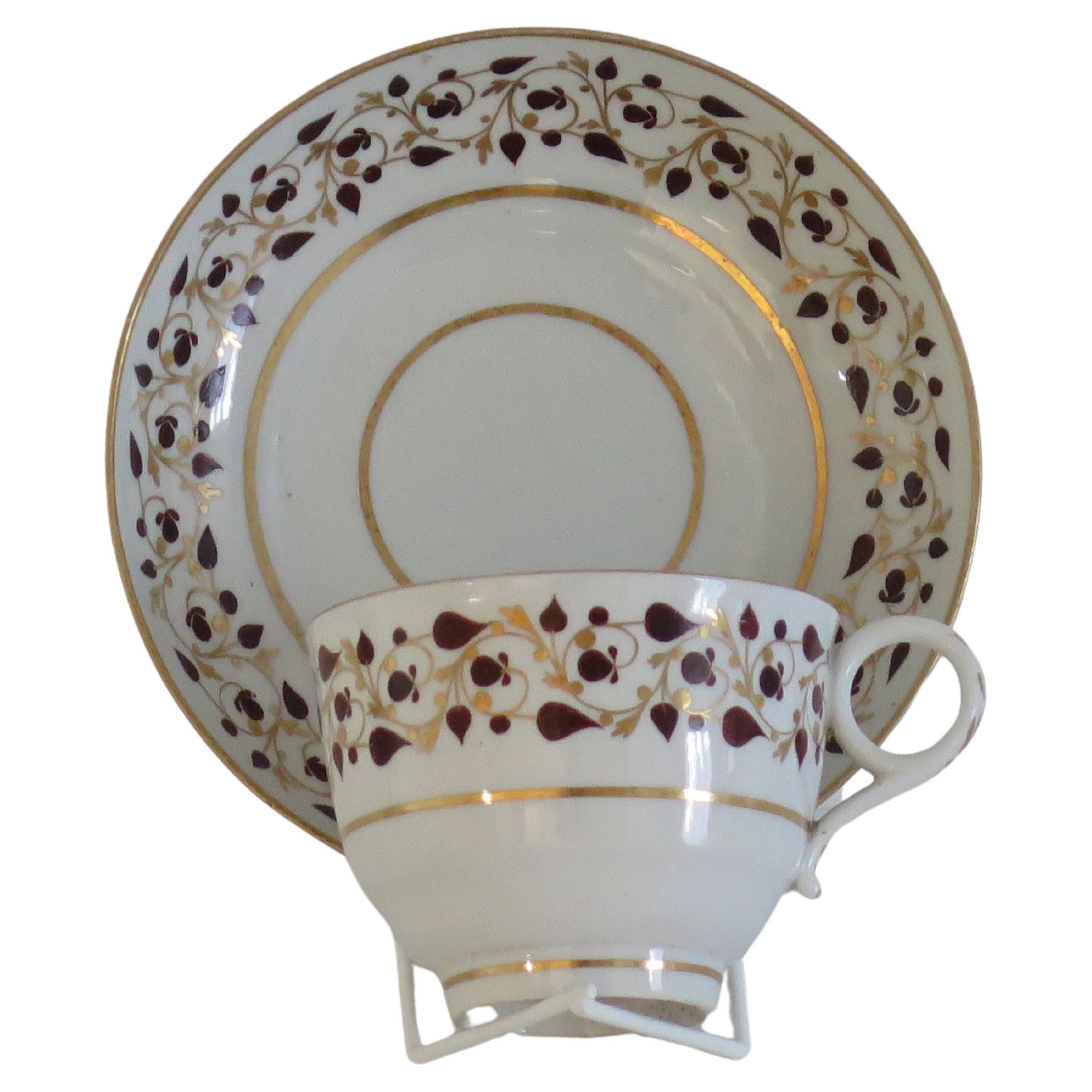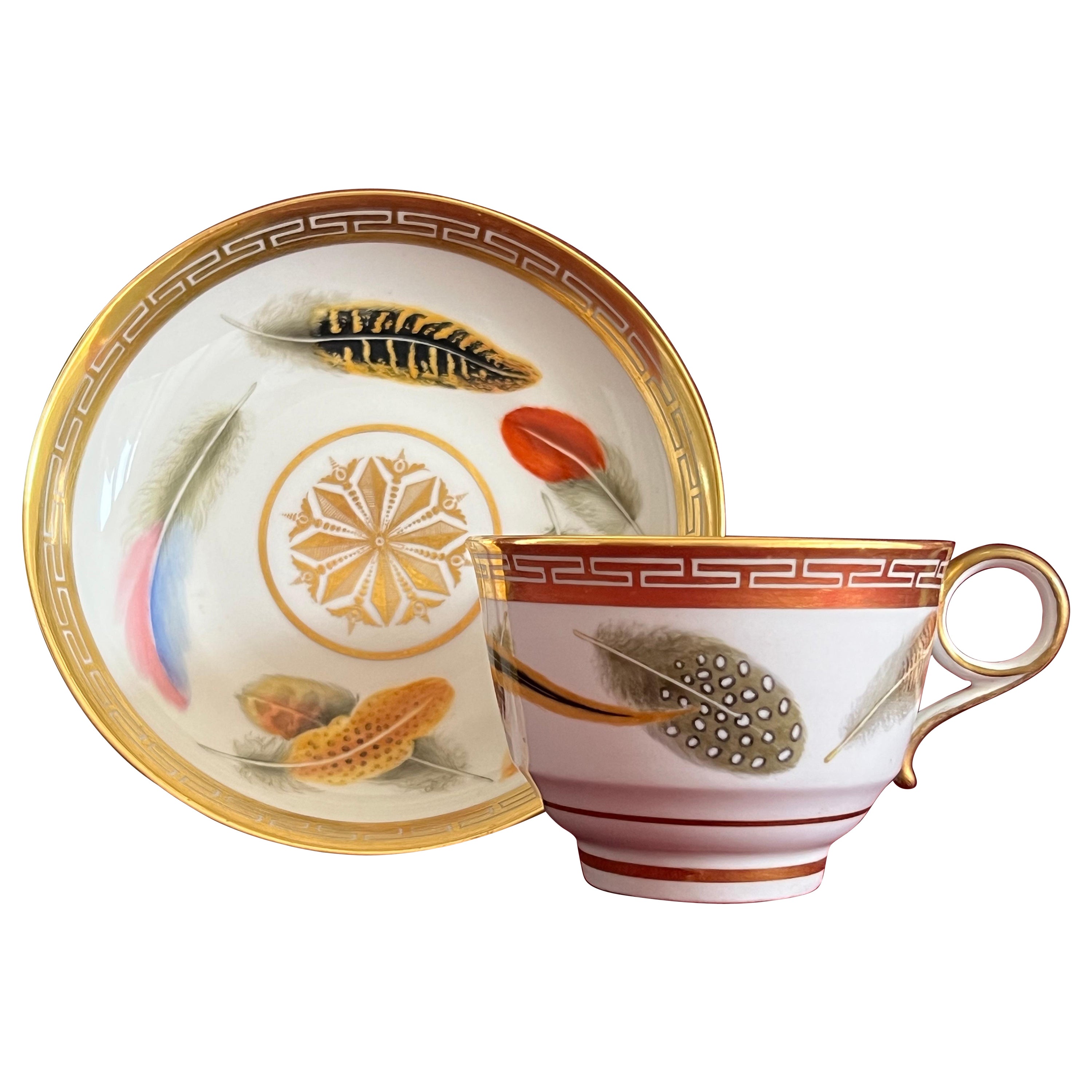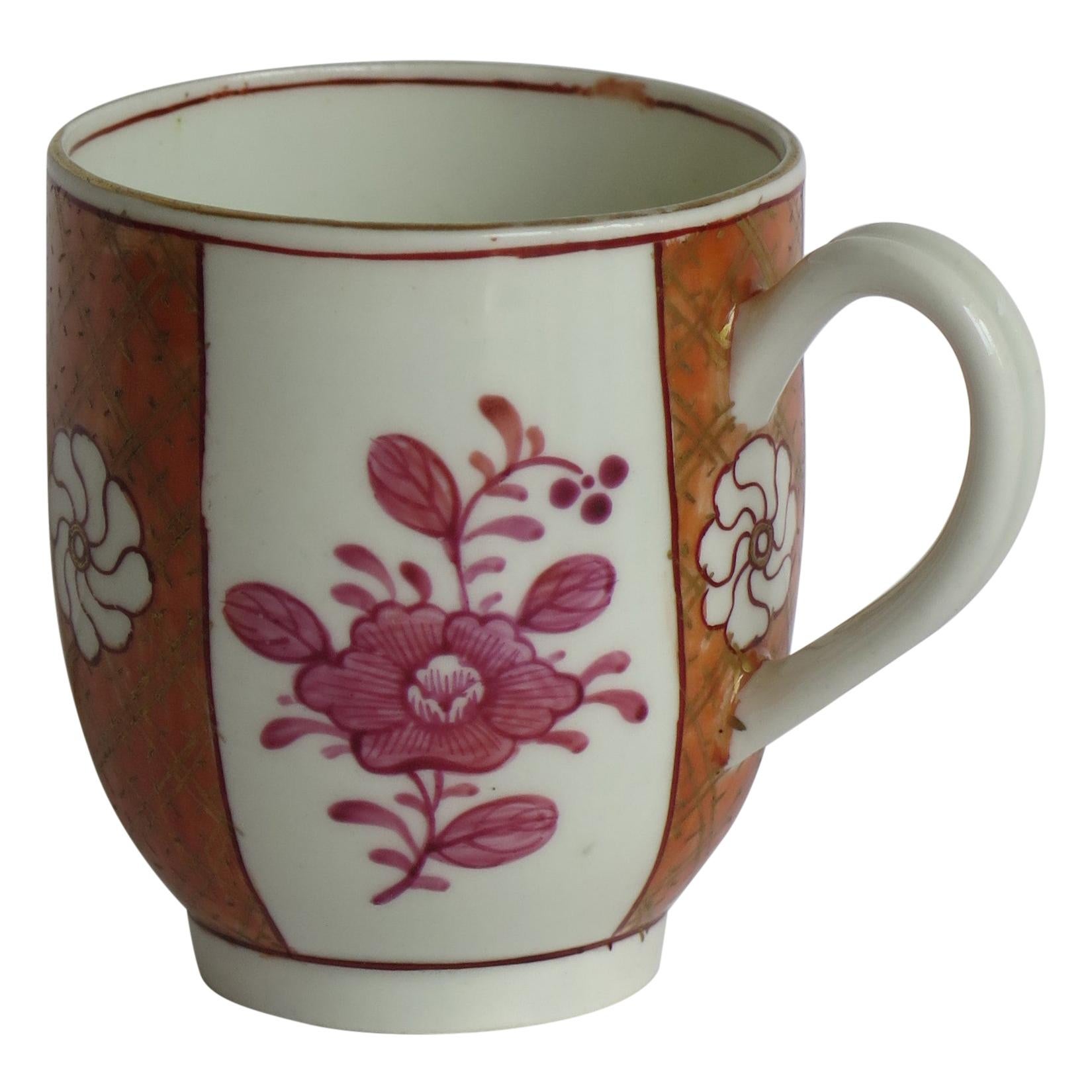Items Similar to Worcester Barr Period Porcelain Coffee Cup in Royal Lily pattern, circa 1800
Video Loading
Want more images or videos?
Request additional images or videos from the seller
1 of 16
Worcester Barr Period Porcelain Coffee Cup in Royal Lily pattern, circa 1800
About the Item
This is a very good hard paste porcelain early Coffee Can or cup with a loop handle, hand decorated in the Royal Lily pattern by Worcester during the Barr period, fully marked to the base and dating to circa 1792 - 1807.
The piece is well potted with a tapering bucket shaped body, with no foot rim and a loop handle.
The pattern is hand painted in the "Royal Lily" pattern, with a series of hand painted vertical lilies in cobalt blue, with mazarine & gilt borders to upper and lower rims and a red/brown upper rim. A nice feature of this early cup is that it is also hand painted to the inner base, with additional gilding to the outer handle. A very similar cup by Worcester in the same pattern is illustrated on Page 75 in the book A Compendium of British Cups by Michael Berthoud .
The base has a scratched "B" to the base indicating it was potted in the Worcester Barr period , Circa 1800.
- Creator:Barr, Flight & Barr Worcester (Manufacturer)
- Dimensions:Height: 2.5 in (6.35 cm)Width: 3.75 in (9.53 cm)Depth: 2.88 in (7.32 cm)
- Style:George III (Of the Period)
- Materials and Techniques:
- Place of Origin:
- Period:
- Date of Manufacture:1792-1807
- Condition:Wear consistent with age and use. NO Damage, NO Restoration. Very good antique condition. Slight wear to the upper rim.
- Seller Location:Lincoln, GB
- Reference Number:
About the Seller
5.0
Platinum Seller
These expertly vetted sellers are 1stDibs' most experienced sellers and are rated highest by our customers.
Established in 1993
1stDibs seller since 2013
1,261 sales on 1stDibs
Typical response time: <1 hour
Associations
LAPADA - The Association of Arts & Antiques Dealers
- ShippingRetrieving quote...Ships From: Lincoln, United Kingdom
- Return PolicyA return for this item may be initiated within 3 days of delivery.
More From This SellerView All
- Worcester Barr Period Porcelain Coffee Can trailing vine pattern, circa 1807By Barr, Flight & Barr WorcesterLocated in Lincoln, LincolnshireThis is a good early Coffee Can or cup with a ring handle, hand decorated with a leaf and gilt intertwining pattern by Worcester during the Barr, Flight and Barr period, fully marked to the base and dating to circa 1807-1813. The piece is well potted with nominally parallel sides and a ring handle. The pattern is hand painted with an intertwining Meander pattern of brown leaves and gilding with additional gilding to the outer handle. Similar coffee cans are illustrated in the book A Compendium of British Cups by Michael Berthoud . The base has a scratched "B" to the base indicating it was potted in the Worcester Barr...Category
Antique Early 19th Century English George III Ceramics
MaterialsPorcelain
- Worcester Barr Period Coffee Can Porcelain Hand Painted, circa 1800By Flight & Barr WorcesterLocated in Lincoln, LincolnshireA very good Porcelain Coffee Can with a ring handle, hand decorated with an orange and gilt pattern by Worcester during the Barr period, fully marked to...Category
Antique Late 18th Century English George III Ceramics
MaterialsPorcelain
- Worcester Barr Flight & Barr Period Porcelain Tea Cup & Saucer Duo, circa 1810Located in Lincoln, LincolnshireThis is a a good early tea cup and saucer duo, hand decorated with a leaf and gilt intertwining pattern by Worcester during the Barr / Barr, Flight and Barr period, fully marked to ...Category
Antique Early 19th Century English George III Ceramics
MaterialsPorcelain
- Georgian Worcester BF&B Porcelain Coffee Can in Hand Gilded Pattern, circa 1810By Barr, Flight & Barr WorcesterLocated in Lincoln, LincolnshireThis is a very good quality coffee can in a hand gilded pattern made by Worcester during the Barr, Flight & Barr period (BFB) of George 111rd years, circa 1807-1813. The coffee ca...Category
Antique Early 19th Century English George III Ceramics
MaterialsPorcelain
- First Period Worcester Coffee Cup Porcelain Finely Hand Painted, circa 1770By 1st Period Worcester Dr. WallLocated in Lincoln, LincolnshireThis is a rare first period (or Dr. Wall) Worcester Coffee Cup, with a distinctive hand painted pattern, made of porcelain and dating to the 18th century, circa 1770. The cup is well potted with a grooved loop handle This delightful early Worcester Cup...Category
Antique 18th Century English George III Ceramics
MaterialsPorcelain
- John Rose Coalport TRIO Porcelain Gilded Royal Garter Pattern, Circa 1800By Coalport PorcelainLocated in Lincoln, LincolnshireThis is an early porcelain trio comprising a coffee can, tea cup and saucer, all in gilded patterns, which we attribute to Coalport, John Rose & Co., Shropshire, England, made at the...Category
Antique Late 18th Century English George III Ceramics
MaterialsPorcelain
You May Also Like
- Fine Flight & Barr Worcester Porcelain Teacup & Saucer, circa 1800By Barr, Flight & Barr WorcesterLocated in Exeter, GBA fine Flight and Barr Worcester feather-painted teacup and saucer, circa 1800. Finely painted with a selection of colourful feathers scattered on th...Category
Antique Early 19th Century British Porcelain
MaterialsPorcelain
- Exceptional Barr Flight Barr Worcester Porcelain Platter, 1804-1813By Barr, Flight & Barr WorcesterLocated in Exeter, GBAn exceptional Barr Flight Barr Worcester porcelain platter c.1804-1813 made for the Cookesfamily of Bentley, Worcestershire, Hand Painted with their family crest and motto, DEO REGI...Category
Antique 19th Century British Porcelain
MaterialsPorcelain
- A Barr, Flight & Barr Worcester Porcelain Armorial Fruit Cooler c.1810By Barr, Flight & Barr WorcesterLocated in Exeter, GBA magnificent and rare Barr, Flight & Barr Porcelain Fruit Cooler c.1804-1813. Superbly decorated with a continuous deep orange ground band and heavily gilded, highly detailed rams head handles, greek key motif to header and a crowned deer armorial crest to the front and reverse. The fruit cooler is one of the rarest and most coveted tableware pieces amongst antique porcelain. This example is even more valuable with its original liner and lid. Impressed mark to underside. The first record of ice cream in Britain is 1671 on the menu of a feast for the Knights of the Garter held in St. George's Hall at Windsor Castle. At this time it was considered such an exclusive dish that it appeared only on the king's table. The earliest printed recipe appeared in Mrs Eale's Receipts, a work on confectionary which was published in London, 1718. It was not until the second half of the 18th century that ices became more readily available from confectioner's shops, and these pails were commonly found on upper class homes' sideboards to be used for a dessert of ice cream with cut fruit. If ice alone is used to fill the cover and the bucket, the ice cream melts very quickly. Although there is nothing recorded in literature, it is almost certain that a little salt was sprinkled on the ice. Porcelain is the ideal material for ice cream pails...Category
Antique 19th Century British Porcelain
MaterialsPorcelain
- A Flight, Barr & Barr Worcester Porcelain Cabinet Cup & Stand c.1815By Flight, Barr & Barr WorcesterLocated in Exeter, GBA superb and rare Flight, Barr and Barr Worcester porcelain cabinet cup and stand, c.1815. With twin gilded handles, broad everted rim and a band of white applied pearls below the ri...Category
Antique 19th Century British Porcelain
MaterialsPorcelain
- Flight Barr & Barr Porcelain Cabinet Cup & Saucer Attr Thomas Baxter, circa 1815By Thomas Baxter, Barr, Flight & Barr WorcesterLocated in Atlanta, GAFlight Barr & Barr Porcelain Cabinet Cup & Saucer Attr: Thomas Baxter, circa 1815 One side decorated with a scene of Mettingham Castle - The home of the late Sir John de Norwich in ...Category
Antique Early 19th Century British Ceramics
MaterialsPorcelain
- Early Worcester Flight & Barr Yellow Porcelain CupBy Flight & Barr WorcesterLocated in Fort Lauderdale, FLAn early Worcester Flight & Barr bright yellow beaker with gilding and a finely painted sepia scene of a landscape. The scene, possibly painted by John Pennington, shows two figures ...Category
Antique Early 1800s English Grand Tour Porcelain
MaterialsPorcelain





